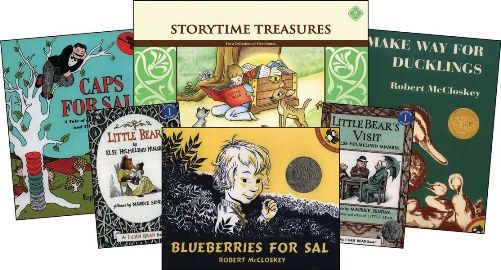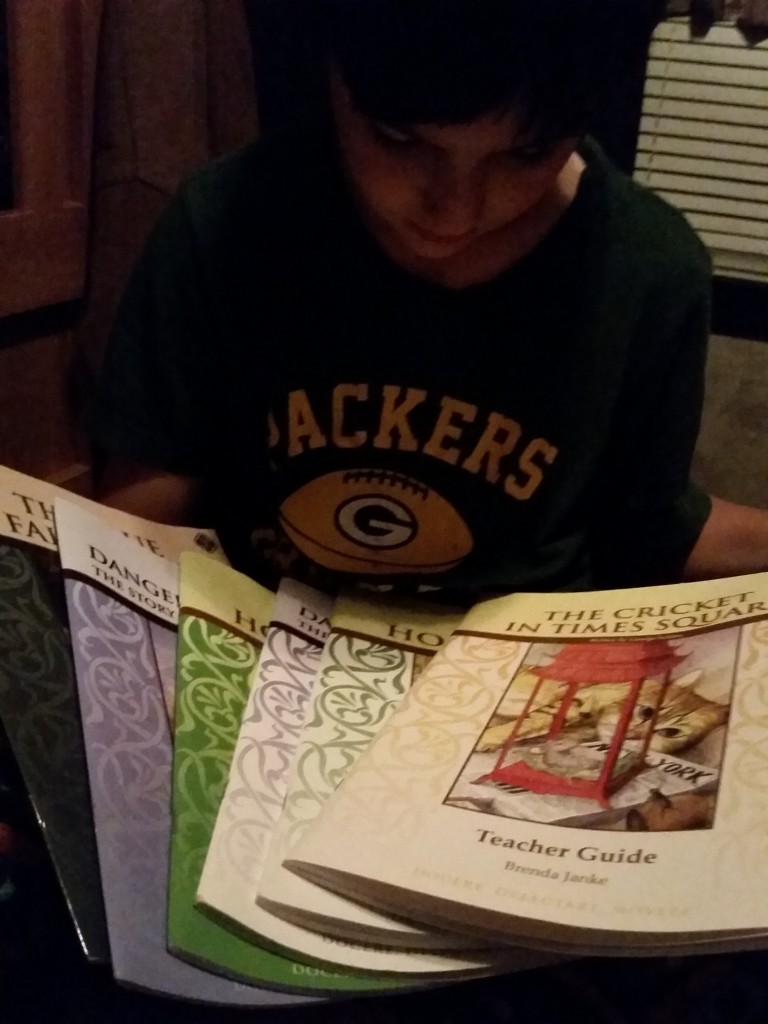It is my legal duty to tell my readers that Memoria Press sent us the four student books and four teacher guides in their Fourth Grade Literature Guide Set to review, and I always perform my legal duty to the letter…except the time I showed up for jury duty with a new baby in my arms. All opinions here belong to me and my children–Memoria Press did not influence our decision.

Most of my readers know that I was an English major in college. What you may not know is that by the time I was finished with college, I rarely read books anymore. The joy of reading had been stifled by too much literary dissection and over-the-top analysis. The natural process of thinking through an author’s work and making friends with writers and characters had been replaced with trying to figure out what a professor thought the author intended to say and making friends with a syllabus.
For that reason, the majority of what my children read is not laid out on the operation table to be cut into layer by layer. It is allowed to dance in their brains and on their tongues as they share their own interpretations without my attempting to get what I want out of a reading.
That is why, despite my degree, this literature guide set from Memoria Press is, as far as I can recall, the first I have ever used with my kids. My opinion? I love it! My kids’ opinion? They love it! Let’s talk about why.
- The book selection is challenging, but not impossible by any means. The selection for fourth grade includes Homer Price by McCloskey (an old friend to most reading families or anyone who has fallen in love with the ducks in Boston), The Cricket in Times Square by Seldon, Dangerous Journey: The Story of Pilgrim’s Progress arranged by Hunkin, and Blue Fairy Book by Lang (the book we started with because we already had it on Kindle).
- Together, the series touches on different styles of literature. Some students may not taste certain genres unless required to, and might never otherwise learn that they love it.
- The discussion questions are not tedious or boring. We work through most of the questions out loud, and the kids are super enthusiastic. They do the quizzes on paper, and are just as enthused.
- The questions guide them to think through character traits, but so far have avoided being preachy.
- The Bible is brought into a few of the lessons, particularly in Dangerous Journey.
- The vocabulary words are fun for the kids, because, overall, they are useful words the kids are now noticing or using in their everyday lives. Also, the new words per lesson are minimal–not overwhelming by any means. There are, of course, a few wonky words they will never use again, such as Genus Mephitis from Homer Price, which doesn’t pop up over pizza too often.
- Character, plat, setting, an other literary devices are discussed in the guides here and there, more so in The Cricket in Times Square. The kids learn the literary words without being chased down by a literary bear with a chainsaw…if you catch my drift.
- The books in the series complement each other, but are separate studies, so parents can begin wherever they like.
- Not only is it good for children to read slightly above their grade levels, but to listen as well. Sometimes I read the story aloud; other times the kids read it to themselves. The program is flexible enough to be used however it works best for the family.
- The appendices in three of the four guides add just a little bit extra to make the book that much more interesting, but not so much that you start drooling while reading.
- The study guides introduce brief writing assignments–not torturous. My first grader loved them.
- It’s age and grade flexible. While this is a fourth grade set, most of my kids listened in and the fourth and first graders actively participated. The other grades look equally as flexible, because the literature selections are timeless.
While I most definitely will continue giving my children a selection of books to read that will require no formal written or spoken analysis, and especially no worksheets, I will also continue to work through the rest of the Fourth Grade Literature Guide Set from Memoria Press. It’s that well done, and it doesn’t kill the joy.
Additional thoughts for my fellow roadschoolers:
With the availability of Kindles, you all know that our libraries can come with us–praise God for that! I’m old school and prefer a book in one hand and popcorn in the other, but I’m still ecstatic about how the Kindle has expanded the roadschoolers library. The Memoria Press Teacher’s Guide and Student’s Guide are both quite slim and will likewise not take up much room on the shelf. Three of the four sets can be stowed until needed while keeping the fourth at hand.
While it’s ideal for each child to have her own student book, if you have eight kids and a limited amount of space, you can adapt as we do and as described above.
The flexibility of the program has made it simple for us to have our literary discussions and sometimes readings in the van as we drive. The quizzes and lessons are short enough that they’re not going to get in the way of hiking through Bryce Canyon.
I see no reason why this one shouldn’t make the roadschool cut!
Read what other reviewers have to say right here:






